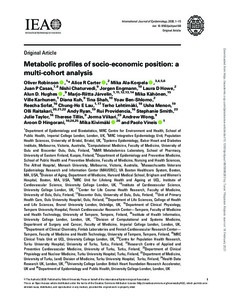Metabolic profiles of socio-economic position: a multi-cohort analysis
Taylor Julie; Casas Juan P; Lehtimäki Terho; Karhunen Ville; Chaturvedi Nishi; Järvelin Marjo-Riitta; Tillin Therese; Robinson Oliver; Shah Tina; Kuh Diana; Ryan Andy; Vineis Paolo; Menon Usha; Engmann Jorgen; Smith Stephanie; Lau Chung-Ho E; Hingorani Aroon D; Sofat Reecha; Viikari Jorma; Hughes Alun D; Carter Alice R; Ala-Korpela Mika; Wong Andrew; Howe Laura D; Kähönen Mika; Providencia Rui; Kivimäki Mika; Ben-Shlomo Yoav; Raitakari Olli
https://urn.fi/URN:NBN:fi-fe2021042826789
Tiivistelmä
Background: Low socio-economic position (SEP) is a risk factor for multiple health outcomes, but its molecular imprints in the body remain unclear.
Methods: We examined SEP as a determinant of serum nuclear magnetic resonance metabolic profiles in ∼30 000 adults and 4000 children across 10 UK and Finnish cohort studies.
Results: In risk-factor-adjusted analysis of 233 metabolic measures, low educational attainment was associated with 37 measures including higher levels of triglycerides in small high-density lipoproteins (HDL) and lower levels of docosahexaenoic acid (DHA), omega-3 fatty acids, apolipoprotein A1, large and very large HDL particles (including levels of their respective lipid constituents) and cholesterol measures across different density lipoproteins. Among adults whose father worked in manual occupations, associations with apolipoprotein A1, large and very large HDL particles and HDL-2 cholesterol remained after adjustment for SEP in later life. Among manual workers, levels of glutamine were higher compared with non-manual workers. All three indicators of low SEP were associated with lower DHA, omega-3 fatty acids and HDL diameter. At all ages, children of manual workers had lower levels of DHA as a proportion of total fatty acids.
Conclusions: Our work indicates that social and economic factors have a measurable impact on human physiology. Lower SEP was independently associated with a generally unfavourable metabolic profile, consistent across ages and cohorts. The metabolites we found to be associated with SEP, including DHA, are known to predict cardiovascular disease and cognitive decline in later life and may contribute to health inequalities.
Keywords: Socio-economic status; education; life course; lipoproteins; metabolomics; metabonomic; occupation.
Kokoelmat
- Rinnakkaistallenteet [19207]
